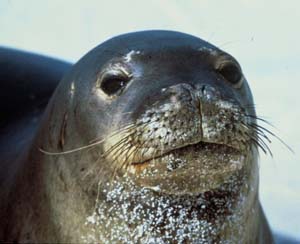Hawaiian Monk Seal
Category: Seal

Facts about Hawaiian Monk Seals. "Scientific name for Hawaiian Monk Seal is Monachus schauinsland". Seals and sea lions and Walruses are semiaquatic mammals they are all in a group called pinnipeds, meaning "fin-footed". Hawaiian Monk Seal is a threatened species of Phocidae family and lives in the Northwestern Hawaiian Islands. These islands are densely populated by humans but surrounded with coral reefs which are useful for food purposes. The Hawaiian Monk Seal is one of the two remaining species of the monk seal and the only one that prefers to stay in warm places.
The Hawaiian Monk Seal has a grey coat, a white belly and a very slender body structure. It does not have external ears, does not rotate its hind flippers under the body. The Hawaiian Monk Seal has a small flat head, large black eyes, short snouts and eight pairs of teeth.
The Hawaiian Monk Seal body structure is perfect for hunting its prey. Having a slender body and hind flippers, make it a very good swimmer. You will find the Hawaiian Monk Seal basking at the sandy beaches when it is not eating or hunting.
Female Hawaiian Monk Seals are generally bigger than the males. They weigh 400 to 600 pounds (181 to 272 kg) whereas the males weigh 300 to 600 pounds (136 to 272 kg).
The mating season occurs in December and august. The mating takes place in water and the female Hawaiian Monk Seal reach maturity at the age of four. The gestation period takes nine months. The pups are given birth in between March and June. Only one pup is born per year.
The pups are born weighing (16 kg) and 1m long. Hawaiian Monk Seals mothers take care of the pups for the first six weeks of their lives before they wean them. They don’t get time to feed at this time so they end up losing so much weight.
The Hawaiian Monk Seal are preyed by sharks, males killing the females for food and fishermen who catch them accidentally while fishing. This explains why their population has been decreasing by day.
Hawaiian monk seals feed on bony fish, cephalopod and crustaceans. The young ones and sub-adults feed on small octopus species like octopus leteus and octopus hawaiiensis. The adults feed on bigger octopi species which are octopus cyanea.

 Back To Category Seal
Back To Category Seal